ECU BUICK RANDEZVOUS 2007 Owner's Manual
[x] Cancel search | Manufacturer: BUICK, Model Year: 2007, Model line: RANDEZVOUS, Model: BUICK RANDEZVOUS 2007Pages: 528, PDF Size: 2.99 MB
Page 7 of 528
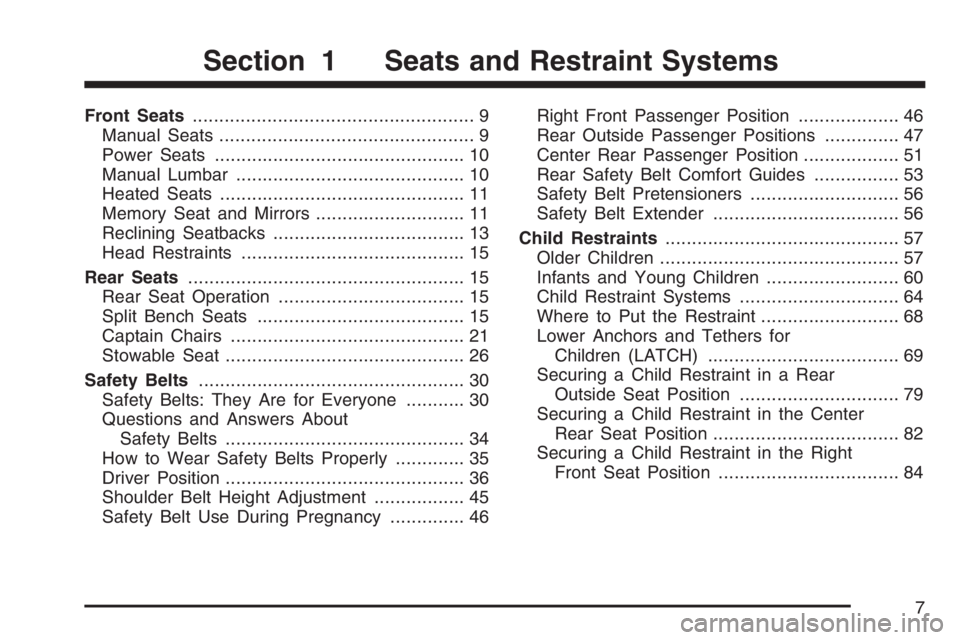
Front Seats..................................................... 9
Manual Seats................................................ 9
Power Seats............................................... 10
Manual Lumbar........................................... 10
Heated Seats.............................................. 11
Memory Seat and Mirrors............................ 11
Reclining Seatbacks.................................... 13
Head Restraints.......................................... 15
Rear Seats.................................................... 15
Rear Seat Operation................................... 15
Split Bench Seats....................................... 15
Captain Chairs............................................ 21
Stowable Seat............................................. 26
Safety Belts.................................................. 30
Safety Belts: They Are for Everyone........... 30
Questions and Answers About
Safety Belts............................................. 34
How to Wear Safety Belts Properly............. 35
Driver Position............................................. 36
Shoulder Belt Height Adjustment................. 45
Safety Belt Use During Pregnancy.............. 46Right Front Passenger Position................... 46
Rear Outside Passenger Positions.............. 47
Center Rear Passenger Position.................. 51
Rear Safety Belt Comfort Guides................ 53
Safety Belt Pretensioners............................ 56
Safety Belt Extender................................... 56
Child Restraints............................................ 57
Older Children............................................. 57
Infants and Young Children......................... 60
Child Restraint Systems.............................. 64
Where to Put the Restraint.......................... 68
Lower Anchors and Tethers for
Children (LATCH).................................... 69
Securing a Child Restraint in a Rear
Outside Seat Position.............................. 79
Securing a Child Restraint in the Center
Rear Seat Position................................... 82
Securing a Child Restraint in the Right
Front Seat Position.................................. 84
Section 1 Seats and Restraint Systems
7
Page 37 of 528

4. Push the latch plate into the buckle until it
clicks.
If the belt stops before it reaches the buckle,
tilt the latch plate and keep pulling until
you can buckle it.
Pull up on the latch plate to make sure it is
secure. If the belt is not long enough,
seeSafety Belt Extender on page 56.
Make sure the release button on the buckle is
positioned so you would be able to unbuckle
the safety belt quickly if you ever had to.5. Move the shoulder belt height adjuster to the
height that is right for you. Improper shoulder
belt height adjustment could reduce the
effectiveness of the safety belt in a crash. See
Shoulder Belt Height Adjustment on page 45.
6. To make the lap part tight, pull up on the
shoulder belt.
It may be necessary to pull stitching on the
safety belt through the latch plate to fully
tighten the lap belt on smaller occupants.
37
Page 48 of 528
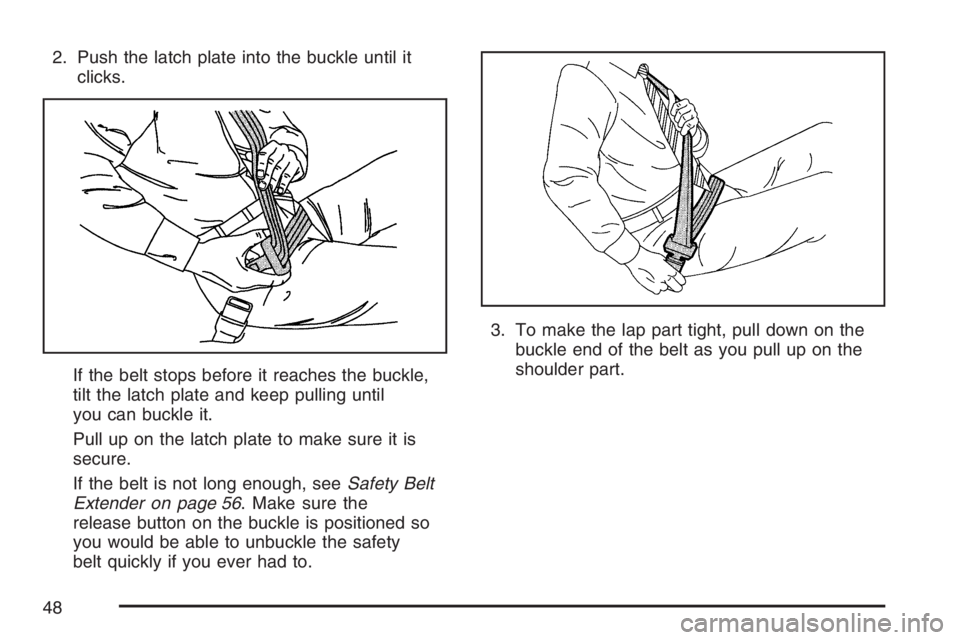
2. Push the latch plate into the buckle until it
clicks.
If the belt stops before it reaches the buckle,
tilt the latch plate and keep pulling until
you can buckle it.
Pull up on the latch plate to make sure it is
secure.
If the belt is not long enough, seeSafety Belt
Extender on page 56. Make sure the
release button on the buckle is positioned so
you would be able to unbuckle the safety
belt quickly if you ever had to.3. To make the lap part tight, pull down on the
buckle end of the belt as you pull up on the
shoulder part.
48
Page 56 of 528
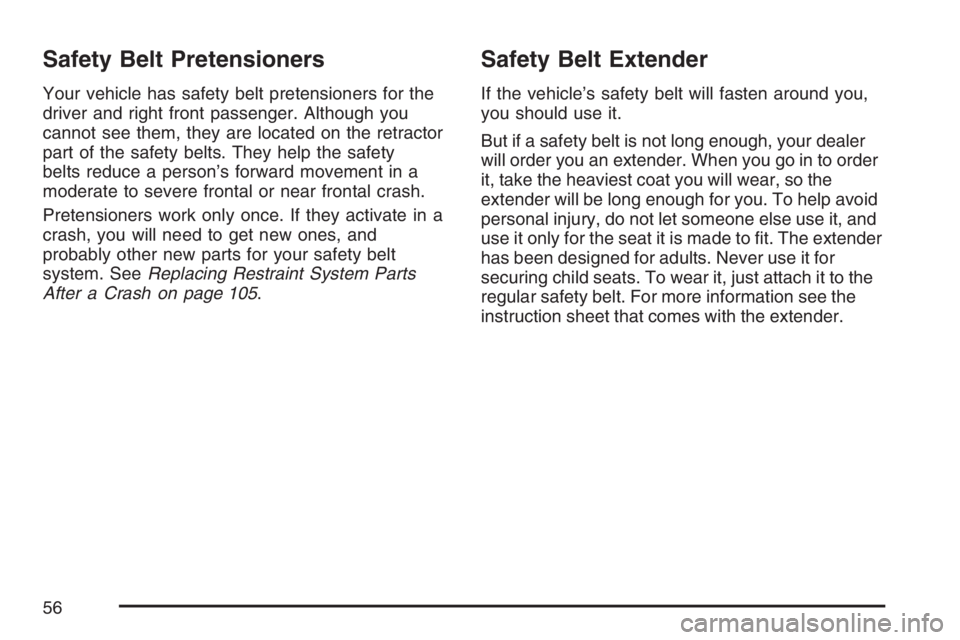
Safety Belt Pretensioners
Your vehicle has safety belt pretensioners for the
driver and right front passenger. Although you
cannot see them, they are located on the retractor
part of the safety belts. They help the safety
belts reduce a person’s forward movement in a
moderate to severe frontal or near frontal crash.
Pretensioners work only once. If they activate in a
crash, you will need to get new ones, and
probably other new parts for your safety belt
system. SeeReplacing Restraint System Parts
After a Crash on page 105.
Safety Belt Extender
If the vehicle’s safety belt will fasten around you,
you should use it.
But if a safety belt is not long enough, your dealer
will order you an extender. When you go in to order
it, take the heaviest coat you will wear, so the
extender will be long enough for you. To help avoid
personal injury, do not let someone else use it, and
use it only for the seat it is made to �t. The extender
has been designed for adults. Never use it for
securing child seats. To wear it, just attach it to the
regular safety belt. For more information see the
instruction sheet that comes with the extender.
56
Page 61 of 528
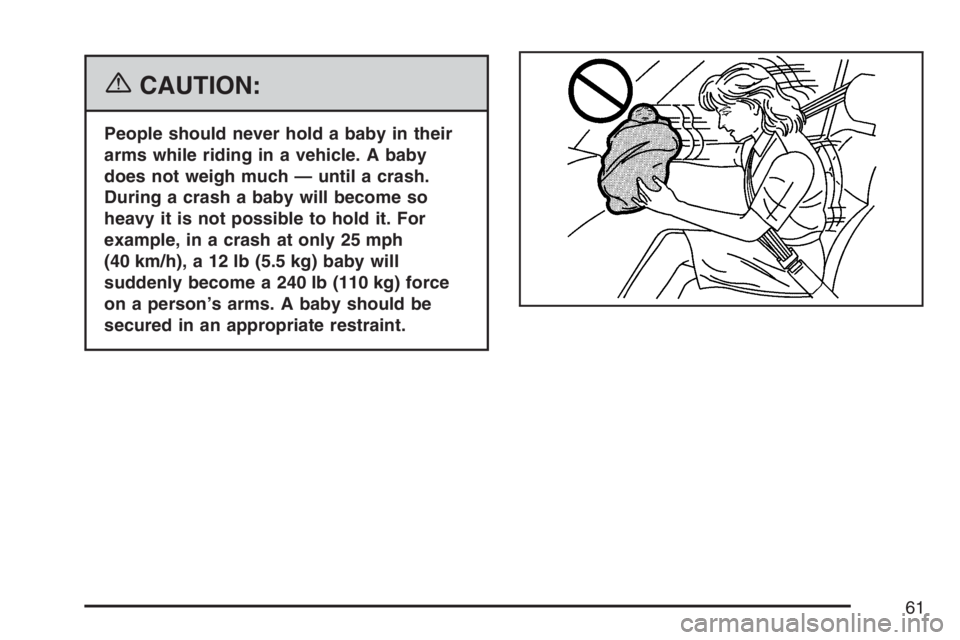
{CAUTION:
People should never hold a baby in their
arms while riding in a vehicle. A baby
does not weigh much — until a crash.
During a crash a baby will become so
heavy it is not possible to hold it. For
example, in a crash at only 25 mph
(40 km/h), a 12 lb (5.5 kg) baby will
suddenly become a 240 lb (110 kg) force
on a person’s arms. A baby should be
secured in an appropriate restraint.
61
Page 63 of 528
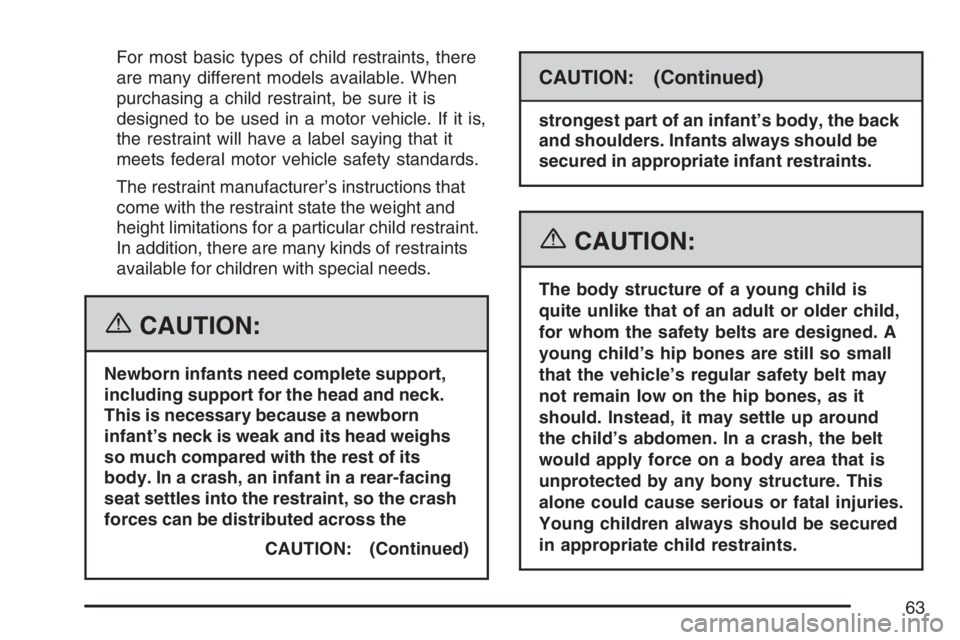
For most basic types of child restraints, there
are many different models available. When
purchasing a child restraint, be sure it is
designed to be used in a motor vehicle. If it is,
the restraint will have a label saying that it
meets federal motor vehicle safety standards.
The restraint manufacturer’s instructions that
come with the restraint state the weight and
height limitations for a particular child restraint.
In addition, there are many kinds of restraints
available for children with special needs.
{CAUTION:
Newborn infants need complete support,
including support for the head and neck.
This is necessary because a newborn
infant’s neck is weak and its head weighs
so much compared with the rest of its
body. In a crash, an infant in a rear-facing
seat settles into the restraint, so the crash
forces can be distributed across the
CAUTION: (Continued)
CAUTION: (Continued)
strongest part of an infant’s body, the back
and shoulders. Infants always should be
secured in appropriate infant restraints.
{CAUTION:
The body structure of a young child is
quite unlike that of an adult or older child,
for whom the safety belts are designed. A
young child’s hip bones are still so small
that the vehicle’s regular safety belt may
not remain low on the hip bones, as it
should. Instead, it may settle up around
the child’s abdomen. In a crash, the belt
would apply force on a body area that is
unprotected by any bony structure. This
alone could cause serious or fatal injuries.
Young children always should be secured
in appropriate child restraints.
63
Page 66 of 528
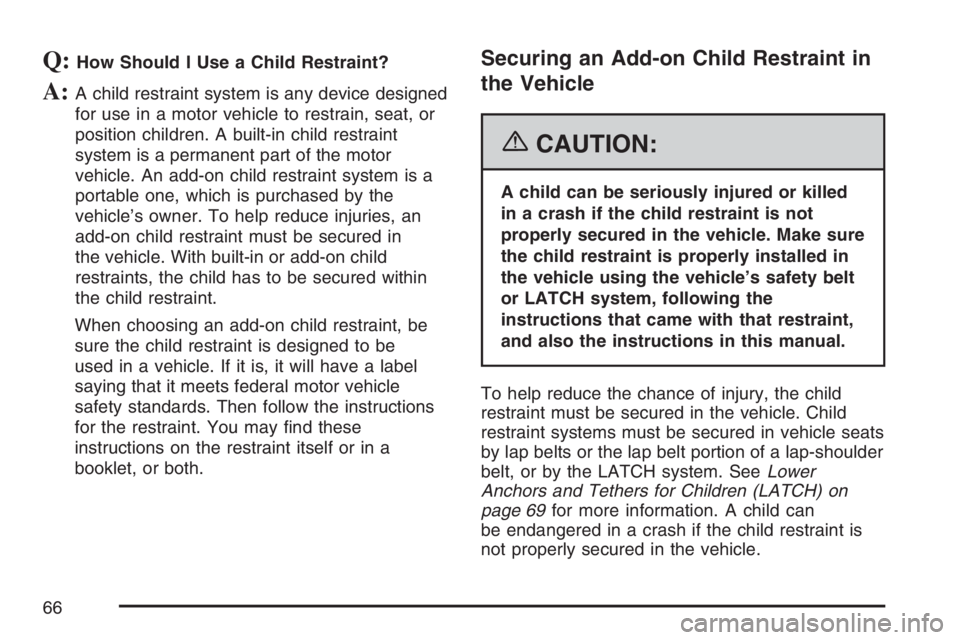
Q:How Should I Use a Child Restraint?
A:A child restraint system is any device designed
for use in a motor vehicle to restrain, seat, or
position children. A built-in child restraint
system is a permanent part of the motor
vehicle. An add-on child restraint system is a
portable one, which is purchased by the
vehicle’s owner. To help reduce injuries, an
add-on child restraint must be secured in
the vehicle. With built-in or add-on child
restraints, the child has to be secured within
the child restraint.
When choosing an add-on child restraint, be
sure the child restraint is designed to be
used in a vehicle. If it is, it will have a label
saying that it meets federal motor vehicle
safety standards. Then follow the instructions
for the restraint. You may �nd these
instructions on the restraint itself or in a
booklet, or both.
Securing an Add-on Child Restraint in
the Vehicle
{CAUTION:
A child can be seriously injured or killed
in a crash if the child restraint is not
properly secured in the vehicle. Make sure
the child restraint is properly installed in
the vehicle using the vehicle’s safety belt
or LATCH system, following the
instructions that came with that restraint,
and also the instructions in this manual.
To help reduce the chance of injury, the child
restraint must be secured in the vehicle. Child
restraint systems must be secured in vehicle seats
by lap belts or the lap belt portion of a lap-shoulder
belt, or by the LATCH system. SeeLower
Anchors and Tethers for Children (LATCH) on
page 69for more information. A child can
be endangered in a crash if the child restraint is
not properly secured in the vehicle.
66
Page 67 of 528
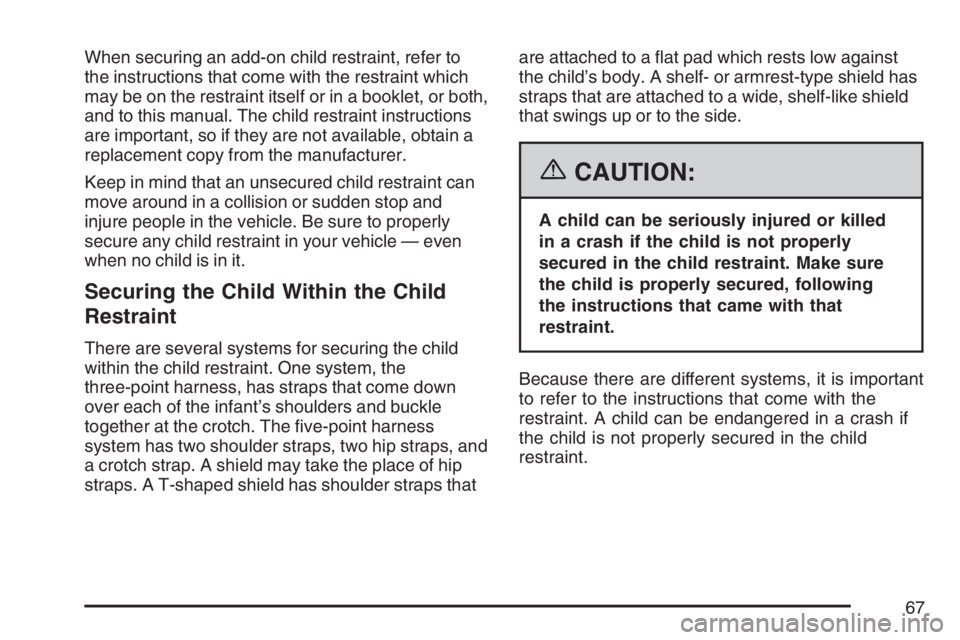
When securing an add-on child restraint, refer to
the instructions that come with the restraint which
may be on the restraint itself or in a booklet, or both,
and to this manual. The child restraint instructions
are important, so if they are not available, obtain a
replacement copy from the manufacturer.
Keep in mind that an unsecured child restraint can
move around in a collision or sudden stop and
injure people in the vehicle. Be sure to properly
secure any child restraint in your vehicle — even
when no child is in it.
Securing the Child Within the Child
Restraint
There are several systems for securing the child
within the child restraint. One system, the
three-point harness, has straps that come down
over each of the infant’s shoulders and buckle
together at the crotch. The �ve-point harness
system has two shoulder straps, two hip straps, and
a crotch strap. A shield may take the place of hip
straps. A T-shaped shield has shoulder straps thatare attached to a �at pad which rests low against
the child’s body. A shelf- or armrest-type shield has
straps that are attached to a wide, shelf-like shield
that swings up or to the side.
{CAUTION:
A child can be seriously injured or killed
in a crash if the child is not properly
secured in the child restraint. Make sure
the child is properly secured, following
the instructions that came with that
restraint.
Because there are different systems, it is important
to refer to the instructions that come with the
restraint. A child can be endangered in a crash if
the child is not properly secured in the child
restraint.
67
Page 68 of 528
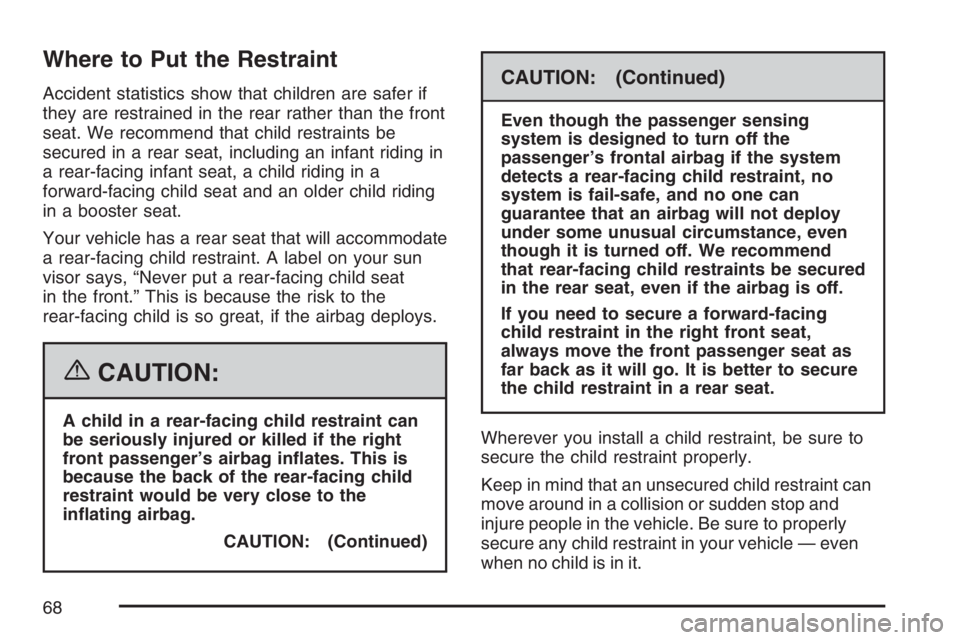
Where to Put the Restraint
Accident statistics show that children are safer if
they are restrained in the rear rather than the front
seat. We recommend that child restraints be
secured in a rear seat, including an infant riding in
a rear-facing infant seat, a child riding in a
forward-facing child seat and an older child riding
in a booster seat.
Your vehicle has a rear seat that will accommodate
a rear-facing child restraint. A label on your sun
visor says, “Never put a rear-facing child seat
in the front.” This is because the risk to the
rear-facing child is so great, if the airbag deploys.
{CAUTION:
A child in a rear-facing child restraint can
be seriously injured or killed if the right
front passenger’s airbag in�ates. This is
because the back of the rear-facing child
restraint would be very close to the
in�ating airbag.
CAUTION: (Continued)
CAUTION: (Continued)
Even though the passenger sensing
system is designed to turn off the
passenger’s frontal airbag if the system
detects a rear-facing child restraint, no
system is fail-safe, and no one can
guarantee that an airbag will not deploy
under some unusual circumstance, even
though it is turned off. We recommend
that rear-facing child restraints be secured
in the rear seat, even if the airbag is off.
If you need to secure a forward-facing
child restraint in the right front seat,
always move the front passenger seat as
far back as it will go. It is better to secure
the child restraint in a rear seat.
Wherever you install a child restraint, be sure to
secure the child restraint properly.
Keep in mind that an unsecured child restraint can
move around in a collision or sudden stop and
injure people in the vehicle. Be sure to properly
secure any child restraint in your vehicle — even
when no child is in it.
68
Page 69 of 528
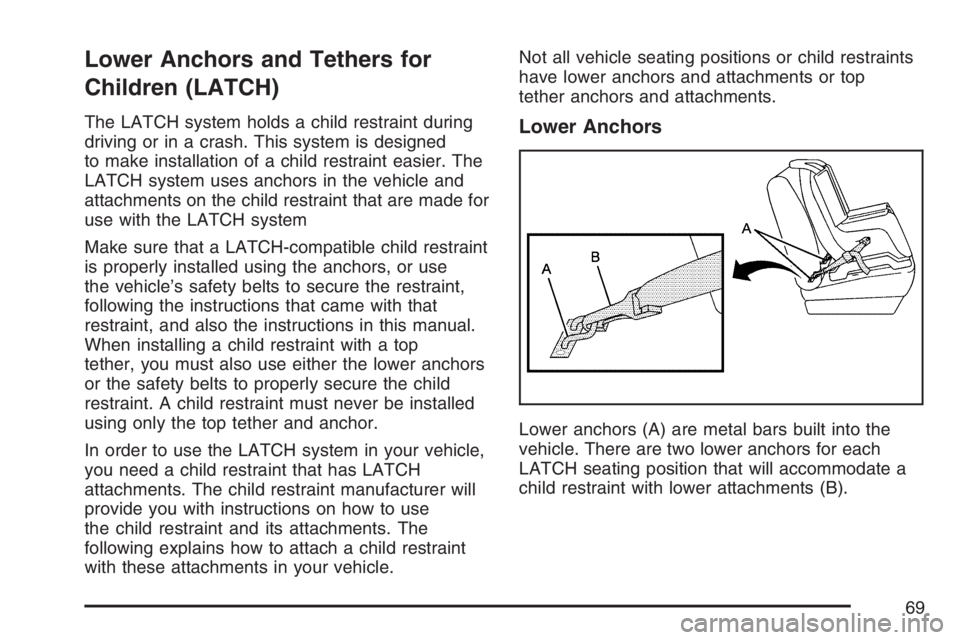
Lower Anchors and Tethers for
Children (LATCH)
The LATCH system holds a child restraint during
driving or in a crash. This system is designed
to make installation of a child restraint easier. The
LATCH system uses anchors in the vehicle and
attachments on the child restraint that are made for
use with the LATCH system
Make sure that a LATCH-compatible child restraint
is properly installed using the anchors, or use
the vehicle’s safety belts to secure the restraint,
following the instructions that came with that
restraint, and also the instructions in this manual.
When installing a child restraint with a top
tether, you must also use either the lower anchors
or the safety belts to properly secure the child
restraint. A child restraint must never be installed
using only the top tether and anchor.
In order to use the LATCH system in your vehicle,
you need a child restraint that has LATCH
attachments. The child restraint manufacturer will
provide you with instructions on how to use
the child restraint and its attachments. The
following explains how to attach a child restraint
with these attachments in your vehicle.Not all vehicle seating positions or child restraints
have lower anchors and attachments or top
tether anchors and attachments.Lower Anchors
Lower anchors (A) are metal bars built into the
vehicle. There are two lower anchors for each
LATCH seating position that will accommodate a
child restraint with lower attachments (B).
69